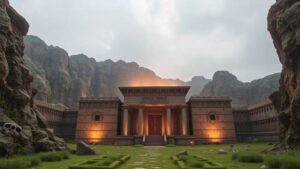Discovering ancient observatories concealed within mountain peaks.
Discovering Ancient Observatories Concealed Within Mountain Peaks
The quest to understand our universe has propelled humanity into some of the most inhospitable terrains on Earth. Among these are the high mountain peaks, where ancient civilizations constructed observatories to track celestial movements. This article delves into significant discoveries of these ancient observatories, their historical significance, and the techniques used to uncover them.
The Role of Ancient Observatories
Ancient observatories were crucial to the lives of early civilizations, providing insights into agriculture, religious practices, and navigation. e structures, often built with remarkable engineering prowess, allowed cultures such as the Maya, Incas, and ancient Greeks to observe astronomical phenomena with remarkable accuracy.
Notable Discoveries of Ancient Observatories
Throughout history, various mountain peaks have unveiled observatories that have shaped our understanding of ancient astronomy. Here are some pivotal examples:
- Huayna Picchu (Peru): Nestled adjacent to Machu Picchu, this peak houses remnants of an ancient Incan astronomic site. Archaeological studies suggest that the Inca used this location to track solstices and equinoxes, with structures aligned to mark these significant events.
- Chichen Itza (Mexico): The El Caracol structure serves as a prime example of Mayan astronomical ingenuity. Perched atop a hill, this observatory featured a circular tower with slit windows aligned to various celestial bodies, allowing Mayans to make precise astronomical observations.
- Jebel al-madam (Oman): This mountain in the Hajar range reveals ancient petroglyphs and structures that suggest advanced astronomical knowledge among Neolithic societies. Researchers have indicated that the positioning of these structures correlates with lunar cycles.
Techniques for Discovering Ancient Sites
The exploration and discovery of these observatories often rely on a combination of modern technology and archaeological techniques. Some of the methods include:
- Remote Sensing Technologies: Tools like LiDAR (Light Detection and Ranging) allow researchers to scan landscapes from above, revealing features hidden under vegetation or debris. This method has been instrumental in locating sites such as those in the dense jungles of Central America.
- Carbon Dating: By dating organic materials found at these sites, historians can accurately determine the timeline of human activity and the evolution of astronomical practices.
- Ground-Penetrating Radar (GPR): This non-invasive technique provides images of subsurface structures, helping archaeologists unearth the hidden layouts of ancient observatories without disturbing the ground.
The Cultural Impact of These Discoveries
Uncovering ancient observatories not only enhances our knowledge of astronomic practices but also sheds light on the societal structures of these ancient civilizations. For example, studies have shown that the coordination required to build and utilize these observatories necessitated a certain level of governance, social organization, and resource allocation.
Future Implications and Takeaways
The ongoing study of ancient observatories provides a fascinating glimpse into the intellectual capabilities of our ancestors. These sites are more than mere relics; they represent the intersection of science, culture, and history. As technology advances, the potential for discovering new observatories in rocky terrains remains high.
For those interested in pursuing this line of inquiry or visiting historical sites, consider the following actionable takeaways:
- Research and plan visits to major archaeological sites that host ancient observatories, such as Machu Picchu and Chichen Itza.
- Engage with academic literature on the methodologies used in locating and studying these structures.
- Consider the role of astronomy in modern society, and reflect on how these ancient observatories laid the groundwork for contemporary scientific practices.
Ultimately, exploring these ancient observatories offers not only a journey into the past but also a recognition of humanitys ongoing quest to understand the universe we inhabit.



